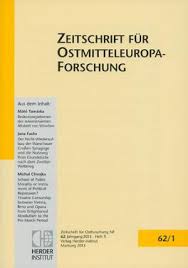Aus der Sowjetunion in das Deutsche Reich: Über die Nachumsiedlung aus Estland im Jahre 1941
From the Soviet Union to the German Reich: About the Nachumsiedlung from Estonia in 1941
Author(s): Olev Liivik, Triin TarkSubject(s): Military history, Political history, WW II and following years (1940 - 1949), Migration Studies, Asylum, Refugees, Migration as Policy-fields
Published by: Verlag Herder-Institut
Keywords: Baltic Germans; World War II; migration; resettlement; Estonia; Soviet Union; National Socialism;
Summary/Abstract: Unlike the first resettlement (Umsiedlung) of Baltic Germans that took place in Estonia from autumn of 1939 to spring of 1940, the operation known as Nachumsiedlung (later resettlement) was carried out in early 1941 under the conditions of Soviet occupation and in a manner that was concealed from the public. The purpose of this article is on the one hand to show how the interests and attitudes of Germany and the Soviet Union influenced the preparation and the execution of the Nachumsiedlung and how the resettlers were dealt with in Germany. On the other hand the article will enlighten the motives and controversial identity of resettlers. The motivation of the German authorities for initiating the Nachumsiedlung can be explained by the addition of potential human resources and material benefit, but the reason for the quick endorsement by the Soviet side remains unclear. Later activities of the Soviets demonstrate their desire to complicate the Nachumsiedlung as much as possible. Joint commissions composed of representatives of the German and Soviet sides were formed for carrying out the Nachumsiedlung. Regular reports submitted by German representatives reflect numerous incidents indicative of the arbitrariness, incompetence and malevolence of Soviet officials. However, due to the fear of Soviet repressions, in addition to the ones from Germans, numerous Estonians and other persons of non-German origin were registered as late resettlers with the assistance of officials from the German side. Many of the resettlers were from mixed families or persons with German origins, who had been assimilated into Estonians during the interwar era. This could also be the reason why they had not taken part in the first resettlement in 1939/40. In Germany, resettlers were divided according to their origins and political credibility. Non-Germans and also many resettlers with German origin were treated as refugees who were placed into refugee camps upon their arrival in Germany. After the outbreak of war between Germany and the Soviet Union, several Estonians who had claimed to be Germans expressed the wish to return to their homeland. Returning to the Baltic countries, however, was made complicated in the latter half of 1941 and essentially, it was mostly possible only for persons in the service of the occupying power. Resettlers with non-German origins often got stuck in Germany’s bureaucratic machinery, neither welcome in Germany, nor with the opportunity to return to their homeland.
Journal: Zeitschrift für Ostmitteleuropa-Forschung
- Issue Year: 65/2016
- Issue No: 3
- Page Range: 407-427
- Page Count: 21
- Language: German

